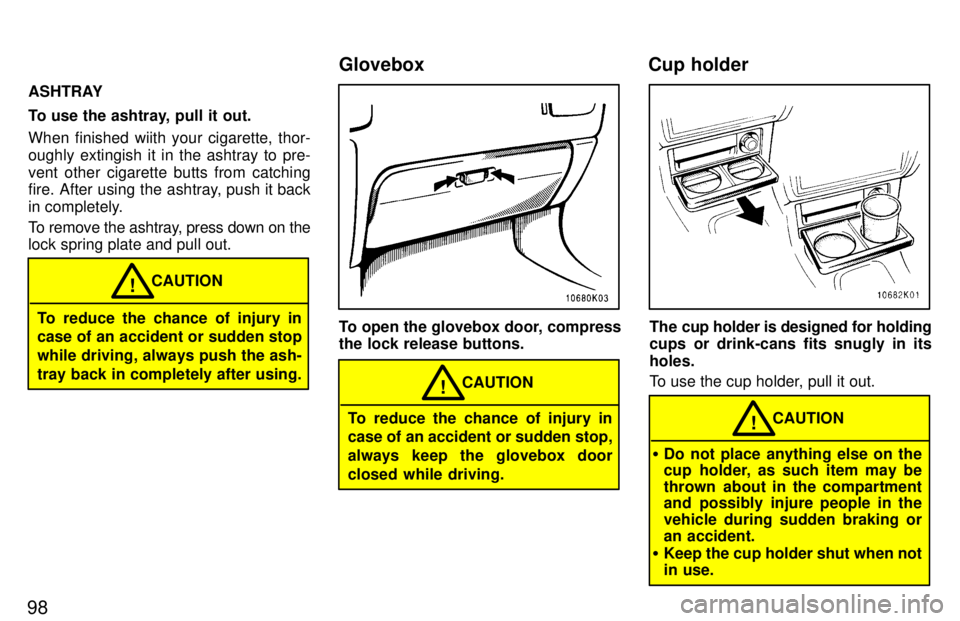TOYOTA TERCEL 1997 Owners Manual
Manufacturer: TOYOTA, Model Year: 1997, Model line: TERCEL, Model: TOYOTA TERCEL 1997Pages: 184, PDF Size: 1.79 MB
Page 91 of 184

89
TREB (Treble)
This knob lets you adjust the treble level. Push BASS/TREBº so that it pops out of
its retracted position. Pull out the knob.
Turn the knob to adjust the treble. Push the knob back into its retracted position. TUNE
Tuning
Your Toyota has an electronic tuning radio (ETR). Push and release the
~º (up) or !º
(down) side of TUNEº to step up or down
the station band. If you hear a beep, you
held the button too long and the radio will
go into the seek mode. Seeking
In the seek mode, the radio finds and plays the next station up or down the sta- tion band.
To seek a station, push and hold the ~º or
! º side of TUNEº until you hear a beep.
Do this again to find another station.
To ensure the correct audio system
operation:
�Be careful not to spill beveragesover the audio system.
�Do not put anything other than acassette tape into the slot.
NOTICE
ILLUMINATION CONTROL LOGIC
On some audio-units, when the instru-
ment panel lights are on, the letters on op-
erable buttons of the mode in current use
light up together with the mode selection and eject buttons. RADIO RECEPTION
Usually, a problem with radio reception
does not mean there is a problem with
your radio-it is just the normal result of
conditions outside the vehicle.
For example, nearby buildings and terrain
can interfere with FM reception. Power
lines or telephone wires can interfere with
AM signals. And of course, radio signals
have a limited range, and the farther you are from a station, the weaker its signal
will be. In addition, reception conditions
change constantly as your vehicle moves. Here are some common reception prob- lems
that probably do not indicate a prob-
lem with your radio: FM
Fading and drifing stationsÐGenerally,
the effective range of FM is about 40 km
(25 miles). Once outside this range, you
may notice fading and drifting, which in- crease with the distance from the radio
transmitter. They are often accompanied by distortion.
Multi-pathÐFM signals are reflective,
making it possible for two signals to reach
your antenna at the same time. If this hap-pens, the signals will cancel each other
out, causing a momentary flutter or loss of
reception.
Static and flutteringÐThese occur when
signals are blocked by buildings, trees, or other large objects. Increasing the bass
level may reduce static and fluttering.
Station swappingÐIf the FM signal you are listening to is interrupted or weak-
ened, and there is another strong station
nearby on the FM band, your radio may
tune in the second station until the original
signal can be picked up again.
ÐCar audio system operating hints
Page 92 of 184

90AM
FadingÐAM broadcasts are reflected by the upper atmosphere-especially atnight. These reflected signals can inter-
fere with those received directly from the radio station, causing the radio station tosound alternately strong and weak.
Station interferenceÐwhen a reflected
signal and a signal received directly froma radio station are very nearly the same
frequency, they can interfere with each
other,
making it difficult to hear the broad-
cast.
StaticÐAM is easily affected by external sources of electrical noise, such as high
tension power lines, lightening, or electri- cal motors. This results in static.
CARING FOR YOUR CASSETTE PLAY-
ER AND TAPES
For high perfirmance from your cassette
player and tapes:
Clean the tape head and other parts regu-
larly. � A dirty tape head or tape path can de-
crease sound quality and tangle your
cassette tapes. The easiest way to
clean them is by using a cleaning tape.
(A wet type is recommended.) Use high-quality cassettes. �
Low-quality cassette tapes can cause
many problems, including poor sound, inconsistent playing speed, and
constant auto-reversing. They can
also get stuck or tangled in the cas-
sette player.
� Do not use a cassette if it has been
damaged or tangled or if its label is
peeling off.
� Do not leave a cassette in the player if
you are not listening to it, especially if it is hot outside.
� Store cassettes in their cases and out
of direct sunlight.
� Avoid using cassettes with a total play-
ing time longer than 100 minutes (50
minutes per side). The tape used in
these cassettes is thin and could get
stuck or tangled in the cassette player.
Page 93 of 184

91
1. Air Intake Selector
2. Temperature Selector
3. Air Flow Selector
4. Fan Speed Selector
5. A/Cº Button (on some models)
Air conditioning systemÐ ÐControls
Page 94 of 184

92Fan speed selector
Move the lever to adjust the fan speed-to the right to increase, to the left to de-crease.
Temperature selector
Turn the knob to adjust the temperature- to the right to warm, to the left to cool.
Air flow selector
Turn the knob to select the vents used for
air flow.
1. Panel
ÐAir flows mainly from the in-
strument panel vents.
2. Bi-level ÐAir flows from both the floor
vents and the instrument panel vents.
3. Floor ÐAir flows mainly from the floor
vents.
4. Floor/Windshield ÐAir flows mainly
from the floor vents and windshield vents.
5. Windshield ÐAir flows mainly from
the windshield vents. For details about air flow selector settings, see the illustration after A/Cº button.
Page 95 of 184

93
Air intake selector Move the lever to select the air source.
1. RecirculateÐRecirculates the air in-
side the vehicle.
2. Fresh ÐDraws outside air into the sys-
tem. A/Cº button
To turn on the air conditioning, press the
A/Cº button. The A/Cº button indicator
will come on. To turn the air conditioning
off, press the button again.
If the A/Cº button indicator flashes, there
is a problem in the air conditioning system
and the air conditioning automatically
shuts off. If this happens, take your ve-
hicle to a Toyota dealer for service.
Page 96 of 184

94�
To cool off your Toyota after it has been
parked in the hot sun, drive with the
windows open for a few minutes. This
vents the hot air, allowing the air condi-
tioning to cool the interior more quickly.
� Make sure the air intake g rilles in front
of the windshield are not blocked (by
leaves or snow, for example).
� On humid days, do not blow cold air on
the windshield. The windshield could
fog up because of the difference in airtemperature on the inside and outside
of the windshield.
� Keep the area under the front seats
clear to allow air to circulate through-out the vehicle.
� On cold days, move the fan speed to
HIº for a minute to help clear the in-
take ducts of snow or moisture. This
can reduce the amount of fogging onthe windows.
ÐAir flow selector settings
ÐOperating tips
Page 97 of 184

95
Heating
For best results, set controls to:
Fan speed ÐAny setting except OFFº
Temperature Ð Towards WARM
(red zone)
Air intake ÐFRESH (outside air)
Air flow ÐFLOOR
Air conditioning ÐOFF
� For quick heating, select recirculated
air for a few minutes. To keep the win-
dows from fogging, select fresh afterthe vehicle interior has been warmed.
� Press the A/Cº button on for dehumid-
ified heating.
� Choose floor/windshield air flow toheat the vehicle interior while defrost-ing or defogging the windshield. Air conditioning For best results, set controls to:
Fan speed ÐAny setting except OFFº
Temperature Ð Towards COLD
(blue zone)
Air intake ÐFRESH (outside air)
Air flow ÐPANEL
Air conditioning ÐON� For quick cooling, move the air intake
selector to recirculate for a few min-utes.
Ventilation
For best results, set controls to:
Fan speed ÐAny setting except OFFº
Temperature Ð Towards COLD
(blue zone)
Air intake ÐFRESH (outside air)
Air flow ÐPANEL
Air conditioning ÐOFF
Defogging The inside of the windshield For best results, set controls to:
Fan speed ÐAny setting except OFFº
Temperature ÐTowards WARM
(red zone) to heat; COLD (blue zone) to
cool
Air intake ÐFRESH (outside air)
Air flow ÐWINDSHIELD
Air conditioning ÐON
� On humid days, do not blow cold air on
the windshieldÐthe difference be-tween the outside and inside tempera-
tures could make the fogging worse.
Defrosting The outside of the windshield For best results, set controls to:
Fan speed ÐAny setting except OFFº
Temperature Ð Towards WARM
(red zone)
Air intake ÐFRESH (outside air)
Air flow ÐWINDSHIELD
Air conditioning ÐOFF
� To heat the vehicle interior while de-
frosting the windshield, choose floor/
windshield air flow.
Page 98 of 184

96
If air flow control is not satisfactory, check
the side vents. The side vents may be
opened or closed as shown.
ÐSide vents
Page 99 of 184

Part 1Clock Cigarette lighter and ashtray
97
OPERATION OF INSTRUMENTS ANDCONTROLSÐ
Chapter 1-8 Other equipment �
Clock
�Cigarette lighter and ashtray
�Glovebox
�Cup holder
�Floor mat
The digital clock indicates the time.
The key must be in the ACCº or ONº position.
To reset the hour: Push the Hº button.
To reset the minutes: Push the Mº button.
Once the electrical power source has
been disconnected from the clock, the
time is automatically set to 1:00 (one o'clock). When the instrument panel lights are turned on, the brightness of the time indi- cation will be reduced.CIGARETTE LIGHTER
To use the cigarette lighter, press it in.
When it becomes heated, it automati-
cally pops out ready for use.
If the engine is not running, the key must be in the ºACCº position.
Do not hold the cigarette lighter pressed in.
Use a Toyota genuine cigarette lighter or equivalent for replacement.
Page 100 of 184

98ASHTRAY
To use the ashtray, pull it out. When finished wiith your cigarette, thor- oughly extingish it in the ashtray to pre-
vent other cigarette butts from catching
fire. After using the ashtray, push it back
in completely.
To remove the ashtray, press down on the lock spring plate and pull out.
To reduce the chance of injury in
case of an accident or sudden stop while driving, always push the ash-tray back in completely after using.
CAUTION
!
To open the glovebox door, compress
the lock release buttons.
To reduce the chance of injury in
case of an accident or sudden stop,
always keep the glovebox door
closed while driving.
CAUTION
!
The cup holder is designed for holding
cups or drink-cans fits snugly in its holes.
To use the cup holder, pull it out.
�
Do not place anything else on the
cup holder, as such item may be
thrown about in the compartment
and possibly injure people in the vehicle during sudden braking or
an accident.
� Keep the cup holder shut when not
in use. CAUTION
!
Cup holder
Glovebox